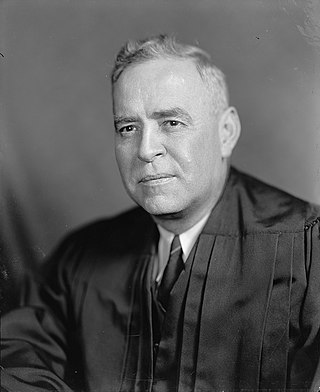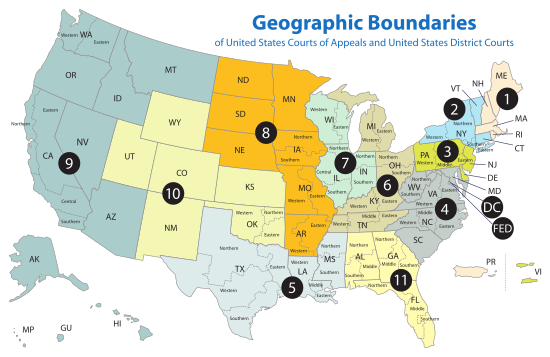
Hugo Lafayette Black was an American lawyer, politician, and jurist who served as a U.S. Senator from Alabama from 1927 to 1937 and as an associate justice of the U.S. Supreme Court from 1937 to 1971. A member of the Democratic Party and a devoted New Dealer, Black endorsed Franklin D. Roosevelt in both the 1932 and 1936 presidential elections.

The Supreme Court of the United States is the highest-ranking judicial body in the United States. Established by Article III of the Constitution, the detailed structure of the court was laid down by the 1st United States Congress in 1789. Congress specified the Court's original and appellate jurisdiction, created 13 judicial districts, and fixed the initial size of the Supreme Court. The number of justices on the Supreme Court changed six times before settling at the present total of nine in 1869. As of June 2022, a total of 116 justices have served on the Supreme Court since 1789. Justices have life tenure, and so they serve until they die in office, resign or retire, or are impeached and removed from office.

Felix Frankfurter was an Austrian-born American jurist who served as an Associate Justice of the Supreme Court of the United States from 1939 until 1962, during which he was an advocate of judicial restraint.

Charles Evans Whittaker was an Associate Justice of the United States Supreme Court from 1957 to 1962. After working in private practice in Kansas City, Missouri, he was nominated for the United States District Court for the Western District of Missouri. In 1956, President Dwight D. Eisenhower nominated Whittaker to the United States Court of Appeals for the Eighth Circuit. In 1957, he won confirmation to the Supreme Court of the United States, thus becoming the first individual to serve as a judge on a federal district court, a federal court of appeals, and the United States Supreme Court. During his brief tenure on the Warren Court, Whittaker emerged as a swing vote. In 1962, he had a nervous breakdown and resigned from the Court. After leaving the Supreme Court, he served as chief counsel to General Motors and frequently criticized the Civil Rights Movement and the Warren Court.

Wiley Blount Rutledge Jr. was an American jurist who served as an associate justice of the Supreme Court of the United States from 1943 to 1949. The ninth and final justice appointed by President Franklin D. Roosevelt, he is best known for his impassioned defenses of civil liberties. Rutledge favored broad interpretations of the First Amendment, the Due Process Clause, and the Equal Protection Clause, and he argued that the Bill of Rights applied in its totality to the states. He participated in several noteworthy cases involving the intersection of individual freedoms and the government's wartime powers. Rutledge served on the Court until his death at the age of fifty-five. Legal scholars have generally thought highly of the justice, although the brevity of his tenure has minimized his impact on history.

The "Four Horsemen" was the nickname given by the press to four conservative members of the United States Supreme Court during the 1932–1937 terms, who opposed the New Deal agenda of President Franklin D. Roosevelt. They were Justices Pierce Butler, James Clark McReynolds, George Sutherland, and Willis Van Devanter. They were opposed by the liberal "Three Musketeers"—Justices Louis Brandeis, Benjamin Cardozo, and Harlan Stone. Chief Justice Charles Evans Hughes and Justice Owen J. Roberts controlled the balance. Hughes was more inclined to join the liberals, but Roberts was often swayed to the side of the conservatives.
Senatorial courtesy is a long-standing, unwritten, unofficial, and nonbinding constitutional convention in the U.S. describing the tendency of U.S. senators to support a Senate colleague opposing the appointment to federal office of a nominee from that senator's state. The practice is motivated by a general sense of collegiality among senators and the assumption that a Senate colleague will have the best first-hand knowledge of the personal character and qualifications of a nominee from the senator's own state. It is also viewed as an "important source of political patronage" for U.S. senators.

Willis Van Devanter was an American lawyer who served as an associate justice of the Supreme Court of the United States from 1911 to 1937. He was a staunch conservative and was regarded as a part of the Four Horsemen, the conservative bloc which dominated the Supreme Court during the 1930s.

During his two terms in office, President Harry S. Truman appointed four members of the Supreme Court of the United States: Chief Justice Fred M. Vinson, Associate Justice Harold Burton, Associate Justice Tom C. Clark, and Associate Justice Sherman Minton.
During his only term in office, President Herbert Hoover appointed three members of the Supreme Court of the United States: Chief Justice Charles Evans Hughes, and Associate Justices Owen Roberts and Benjamin Cardozo. Additionally, with his failed nomination of John J. Parker, Hoover became the first president since Grover Cleveland to have a Supreme Court nomination rejected by the United States Senate.

The nomination and confirmation of justices to the Supreme Court of the United States involves several steps, the framework for which is set forth in the United States Constitution. Specifically, Article II, Section 2, Clause 2, provides that the president of the United States nominates a justice and that the United States Senate provides advice and consent before the person is formally appointed to the Court. It also empowers a president to temporarily, under certain circumstances, fill a Supreme Court vacancy by means of a recess appointment. The Constitution does not set any qualifications for service as a justice, thus the president may nominate any individual to serve on the Court.

The Hughes Court refers to the Supreme Court of the United States from 1930 to 1941, when Charles Evans Hughes served as Chief Justice of the United States. Hughes succeeded William Howard Taft as Chief Justice after the latter's retirement, and Hughes served as Chief Justice until his retirement, at which point Harlan Stone was nominated and confirmed as Hughes's replacement. The Supreme Court moved from its former quarters at the United States Capitol to the newly constructed Supreme Court Building during Hughes's chief-justiceship.

The Stone Court refers to the Supreme Court of the United States from 1941 to 1946, when Harlan F. Stone served as Chief Justice of the United States. Stone succeeded the retiring Charles Evans Hughes in 1941, and served as Chief Justice until his death, at which point Fred Vinson was nominated and confirmed as Stone's replacement. He was the fourth chief justice to have previously served as an associate justice and the second to have done so without a break in tenure. Presiding over the country during World War II, the Stone Court delivered several important war-time rulings, such as in Ex parte Quirin, where it upheld the President's power to try Nazi saboteurs captured on American soil by military tribunals. It also supported the federal government's policy of relocating Japanese Americans into internment camps.

The Vinson Court refers to the Supreme Court of the United States from 1946 to 1953, when Fred M. Vinson served as Chief Justice of the United States. Vinson succeeded Harlan F. Stone as Chief Justice after the latter's death, and Vinson served as Chief Justice until his death, at which point Earl Warren was nominated and confirmed to succeed Vinson.
Woodrow Wilson appointed three Associate Justices to the Supreme Court of the United States, James Clark McReynolds, Louis Brandeis, and John Hessin Clarke.
Harlan F. Stone was nominated and confirmed twice to the Supreme Court of the United States. First in 1925, when President Calvin Coolidge nominated him to serve as an associate justice and again in 1941, when President Franklin D. Roosevelt nominated Justice Stone to be elevated to Chief Justice. Both times, the United States Senate confirmed the nominations.

Sherman Minton was nominated to serve as an associate justice of the Supreme Court of the United States by U.S. President Harry S. Truman on September 14, 1949, after the death in office of Wiley Rutledge created a vacancy on the Supreme Court. Per the Constitution of the United States, Minton's nomination was subject to the advice and consent of the United States Senate, which holds the determinant power to confirm or reject nominations to the U.S. Supreme Court. The nomination was met with a mixed reception and faced active opposition stemming both from the belief that Minton would be a liberal justice and from his history as a New Deal-supporting member of the United States Senate. There was an unsuccessful effort to compel Minton to testify before the United States Senate Committee on the Judiciary. Nevertheless, the nomination was approved by a 48–16 vote of the United States Senate on October 4, 1949.

Wiley Rutledge was nominated to serve as an associate justice of the Supreme Court of the United States by U.S. President Franklin D. Roosevelt on January 11, 1943, after the resignation of James F. Byrnes created a vacancy on the court. Per the Constitution of the United States, Rutledge's nomination was subject to the advice and consent of the United States Senate, which holds the determinant power to confirm or reject nominations to the U.S. Supreme Court. After being favorably reported on by both a subcommittee of the Senate Committee on the Judiciary and the full Judiciary Committee, the nomination was confirmed by the full Senate through a voice vote on February 8, 1943.

Thurgood Marshall was nominated to serve as an associate justice of the Supreme Court of the United States by U.S. President Lyndon B. Johnson on June 13, 1967 to fill the seat being vacated by Tom C. Clark. Per the Constitution of the United States, the nomination was subject to the advice and consent of the United States Senate, which holds the determinant power to confirm or reject nominations to the U.S. Supreme Court. Marshall was confirmed by the U.S. Senate in a 69–11 vote on August 30, 1967, becoming the first African American member of the Court, and the court's first non-white justice.













